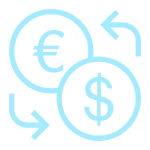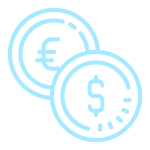Every market has a spread. The Forex market is no exception. Spread is an inseparable part of trading and is the profit taken by the broker. In general, spread in FX equals the differences between selling and buying prices. When trading Forex, whether through a Forex account or using spread betting, the broker doesn’t charge you a fixed or monthly fee for operating the account. The broker, also, doesn’t take any direct transaction charges for taking a trade. When a broker does so and requires additional commission fees, that’s usually a bad sign and can be one of the main indicators to detect the scammers.
The broker offers two different prices for a currency trade, often referred to as the bid price and the offer (ask) price. There are the broker prices, describing what the broker is doing. The broker is bidding and offering. You buy at the offer price and sell at the bid price. The difference is called the spread and is the broker’s profit margin. Forex spread margin represents the brokers’ money earnings and gains.
Regularly, traders prefer to trade in a tight spread environment. Tight spread means that the differences between bid and ask prices are minimized. Tight spreads are also known as Forex low spread. Through the Forex lowest spread investors can minimize their costs maximally and get a higher profit.
There are 2 versions of spreads in the FX market – fixed and floating spreads. Fixed spreads are fixed and don’t follow the market’s volatility, while floating spreads are dependent on the market dynamics.
Besides, there are three types of spreads, including bid spread, yield spread, negative spread. The spread types are representing the way the broker can earn money and come in different shapes and sizes.
In this guide you’ll get detailed information about the spread, Forex spreads meaning, spread types and versions, how do they work and what are their main characteristics.
FX Spread Versions and How They Work
 In the FX market, traders come across two versions of spreads. Each of them represents the differences between ask and bid prices. As we already mentioned in the beginning there are two versions of FX spreads, including Forex fixed spreads and floating spreads. It can be said, that they per se show contradictory processes. Let’s see what are the main differences between them.
In the FX market, traders come across two versions of spreads. Each of them represents the differences between ask and bid prices. As we already mentioned in the beginning there are two versions of FX spreads, including Forex fixed spreads and floating spreads. It can be said, that they per se show contradictory processes. Let’s see what are the main differences between them.
Fixed Spread
Forex broker spreads are fixed when the trader gets a guarantee from the broker that no matter what happens and no matter how volatile the market can be the spreads always remain the same. Unlike the floating spread, the fixed spread is set by the broker. No matter how the market tendencies and prices change, Forex fixed spreads are remaining the same. For example, if a broker says that the spread on EUR/USD on their platform is 5 pips, it means that no matter how much the currencies change on their own terms, the spread always stays unchangeable.
Fixed spreads are very helpful for traders, who want to know the spread cost and their bottom line, no matter what are or will be the market’s condition and dynamics. Through the mentioned characteristic, the traders are allowed to develop their own strategy both long and short-term. Fixed spreads support traders with better transparency and more predictability. One of the advantages, as well, traders can get from the fixed spreads, is lower costs. By applying fixed spreads traders can reduce the cost of trading. Because of its predictability traders can follow their aforethought budget and all the costs, that are needed for transactions and are trading-related. Furthermore, traders can be safe while operating through fixed spreads. As long as spreads are fixed, traders can have a sense of safety against the market’s volatility.
Floating Spread
 Unlike the fixed spread, the floating spread is dependent on the market’s volatility. It is based on market demand. It can go high or go down, as well. Its fluctuation is influenced by the changes in currencies’ exchange and price rates. Floating spread, in general, operates through the law of demand and supply.
Unlike the fixed spread, the floating spread is dependent on the market’s volatility. It is based on market demand. It can go high or go down, as well. Its fluctuation is influenced by the changes in currencies’ exchange and price rates. Floating spread, in general, operates through the law of demand and supply.
Apart from that, the floating spread is a constantly changing value between the ask and bid prices. To be more concrete, the spread traders pay for certain currency pairs fluctuates because of the things, which have a crucial effect on the market, including supply and demand.
As we already mentioned in the beginnings there are tight spreads too, which are, in most cases, typical of floating spreads.
Spread in the Forex market is income for the brokers. So, through floating spread, their income is volatile too and the broker gets an unstable income from every trade you conduct. Besides, the income from the floating spread can be minimal, while the trading processes are time-extended and/or quiet and can go up significantly during market turbulence.
One of the advantages of floating spreads is that it allows traders to get plenty of profits and earn money easily in a short time. What’s more, floating spreads are less in size than the fixed ones.
FX Spread Types and Their Quirks
There are several types of FX spreads, which are characterized differently. Some of the most significant types among them are
- Bid/Ask Spread
- Yield Spread
- Negative Spread
As we already mentioned, spread type has one main purpose – to earn a certain amount of money for the broker. After getting short information about the spread types, it’s time to overview three of them and see what are their quirks and their main characteristics.
Bid Spread
Bid spreads in Forex, also known as, ask spread, represent the difference between the bid and the ask prices. The main formula for calculating the payment size through the bid spread is the difference between ask and bid prices multiplied by the lot size. This is the perfect formula, which shows how much traders are spending on spreads.
Yield Spread
 Yield spreads are mostly used for bonds and stocks to calculate the spread in percentage rather than in pips. It can also be used for FX if traders want to calculate the percentage spread. Yields spread supports traders with the opportunity to differentiate two bonds of equal size and value. The difference between their yields will appear in a yield spread. For example, if there’s a bond that has a yield of 20% and there’s another bond with a yield of 10%, this means, that the yield spread is 10%.
Yield spreads are mostly used for bonds and stocks to calculate the spread in percentage rather than in pips. It can also be used for FX if traders want to calculate the percentage spread. Yields spread supports traders with the opportunity to differentiate two bonds of equal size and value. The difference between their yields will appear in a yield spread. For example, if there’s a bond that has a yield of 20% and there’s another bond with a yield of 10%, this means, that the yield spread is 10%.
To put it simply and understand clearly how the yield spread can be used in Forex, we can take an easy example. For instance, let’s imagine, that EUR/GBP has a yield curve of 25% and EUR/USD has 10%. Both the mentioned currency pairs are the major ones among other currency pairs. The yield spread here will be 15% and more likely, people will start trading with EUR/GBP currency pairs, as long as it promises traders better and higher profits. Yield spread has several types of spreads either, including zero-volatility spread (Z-spread). Z-spread, in most cases, is linked to the time-consuming processes, because it requires plenty of calculations. Furthermore, one sub-type of the yield spread is the high-yield bond spread and another one is an option-adjusted spread.
Negative Spread
A Forex negative spread is when traders don’t have to pay anything to the broker. The broker profits so much from holding this trade possible that they don’t have to charge their customers for trading it.
Negative spreads are only negative for the brokers. What’s more, negative spreads seem quite beneficial for the investors. Even though that the broker doesn’t get any spread from the trading process or any additional income from the trader, the broker guarantees all the traders that they’ll get immediately all the profits, that is gained from the trading. However, this happens when the trader makes the correct call. If the currency starts to decrease its value and starts falling, there’s nothing that can save the trader.
The negative spread, the most frequently, is typical of high-interest-rate currencies. As long as high-interest rate currencies promise the brokers great profits, brokers don’t require an additional fee or non-negative spreads from the traders.

